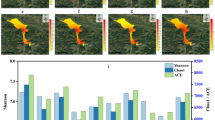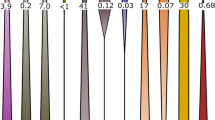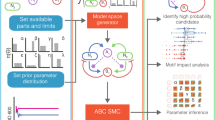Abstract
Acid mine drainage (AMD), an extreme environment characterized by low pH and high metal concentrations, can support dense acidophilic microbial biofilm communities that rely on chemoautotrophic production based on iron oxidation. Field determined production rates indicate that, despite the extreme conditions, these communities are sufficiently well adapted to their habitats to achieve primary production rates comparable to those of microbial communities occurring in some non-extreme environments. To enable laboratory studies of growth, production and ecology of AMD microbial communities, a culturing system was designed to reproduce natural biofilms, including organisms recalcitrant to cultivation. A comprehensive metabolic labeling-based quantitative proteomic analysis was used to verify that natural and laboratory communities were comparable at the functional level. Results confirmed that the composition and core metabolic activities of laboratory-grown communities were similar to a natural community, including the presence of active, low abundance bacteria and archaea that have not yet been isolated. However, laboratory growth rates were slow compared with natural communities, and this correlated with increased abundance of stress response proteins for the dominant bacteria in laboratory communities. Modification of cultivation conditions reduced the abundance of stress response proteins and increased laboratory community growth rates. The research presented here represents the first description of the application of a metabolic labeling-based quantitative proteomic analysis at the community level and resulted in a model microbial community system ideal for testing physiological and ecological hypotheses.
Similar content being viewed by others
Log in or create a free account to read this content
Gain free access to this article, as well as selected content from this journal and more on nature.com
or
References
Alamuri P, Mehta N, Burk A, Maier RJ . (2006). Regulation of the Helicobacter pylori Fe-S cluster synthesis protein NifS by iron, oxidative stress conditions, and Fur. J Bacteriol 188: 5325–5330.
Amann RI . (1995). Fluorescently labelled, rRNA-targeted oligonucleotide probes in the study of microbial ecology. Mol Ecol 4: 543–554.
Baker-Austin C, Dopson M, Wexler M, Sawers RG, Bond PL . (2005). Molecular insight into extreme copper resistance in the extremophilic archaeon ‘Ferroplasma acidarmanus’ Fer1. Microbiology 151: 2637–2646.
Baker BJ, Banfield JF . (2003). Microbial communities in acid mine drainage. FEMS Microbiol Ecol 44: 139–152.
Baker BJ, Tyson GW, Webb RI, Flanagan J, Hugenholtz P, Allen EE et al. (2006). Lineages of acidophilic archaea revealed by community genomic analysis. Science 314: 1933–1935.
Bond PL, Banfield JF . (2001). Design and performance of rRNA targeted oligonucleotide probes for in situ detection and phylogenetic identification of microorganisms inhabiting acid mine drainage environments. Microbial Ecol 2: 149–161.
Bond PL, Druschel GK, Banfield JF . (2000a). Comparison of acid mine drainage microbial communities in physically and geochemically distinct ecosystems. Appl Environ Microbiol 66: 4962–4971.
Bond PL, Smriga SP, Banfield JF . (2000b). Phylogeny of microorganisms populating a thick, subaerial, predominantly lithotrophic biofilm at an extreme acid mine drainage site. Appl Environ Microbiol 66: 3842–3849.
Brock TD . (1978). Thermophilic Microorganisms and Life at High Temperatures. Springer-Verlag: New York, pp 11–37.
Brock TD, Freeze H . (1969). Thermus aquaticus gen. n. and sp. n., a nonsporulating extreme thermophile. J Bacteriol 98: 289–297.
Connon SA, Giovannoni SJ . (2002). High-throughput methods for culturing microorganisms in very-low-nutrient media yield diverse new marine isolates. Appl Environ Microbiol 68: 3878–3885.
Coram NJ, Rawlings DE . (2002). Molecular relationship between two groups of the genus Leptospirillum and the finding that Leptospirillum ferriphilum sp. nov. dominates South African commercial biooxidation tanks that operate at 40 degrees C. Appl Environ Microbiol 68: 838–845.
Denef VJ, VerBerkmoes NC, Shah MB, Abraham P, Lefsrud M, Hettich RL et al. (2009). Proteomics-inferred genome typing (PIGT) demonstrates inter-population recombination as a strategy for environmental adaptation. Environ Microbiol 11: 313–325.
Dick GJ, Andersson A, Baker BJ, Simmons SS, Thomas BC, Yelton AP et al. (2009). Community-wide analysis of microbial genome sequence signatures. Genome Biol 10: R85.
Dopson M, Baker-Austin C, Hind A, Bowman JP, Bond PL . (2004). Characterization of Ferroplasma isolates and Ferroplasma acidarmanus sp. nov., extreme acidophiles from acid mine drainage and industrial bioleaching environments. Appl Environ Microbiol 70: 2079–2088.
Druschel G, Baker B, Gihring T, Banfield J . (2004). Acid mine drainage biogeochemistry at Iron Mountain, California. Geochemical Transactions 5: 13.
Edwards KJ, Bond PL, Gihring TM, Banfield JF . (2000). An archaeal iron-oxidizing extreme acidophile important in acid mine drainage. Science 287: 1796–1799.
Eng JK, McCormack AL, Yates III JR . (1994). An approach to correlate tandem mass spectral data of peptides with amino acid sequences in a protein database. J Am Soc Mass Spectrometry 5: 976–989.
Ferris MJ, Ward DM . (1997). Seasonal distributions of dominant 16S rRNA-defined populations in a hot spring microbial mat examined by denaturing gradient gel electrophoresis. Appl Environ Microbiol 63: 1375–1381.
Fiala G, Stetter KO . (1986). Pyrococcus furiosus sp. nov. represents a novel genus of marine heterotrophic archaebacteria growing optimally at 100 °C. Arch Microbiol 145: 56–61.
Frias-Lopez J, Shi Y, Tyson GW, Coleman ML, Schuster SC, Chisholm SW et al. (2008). Microbial community gene expression in ocean surface waters. Proc Natl Acad Sci USA 105: 3805–3810.
Giovannoni SJ, Revsbech NP, Ward DM, Castenholz RW . (1987). Obligately phototrophic Chloroflexus: primary production in anaerobic hot spring microbial mats. Arch Microbiol 147: 80–87.
Goltsman DSA, Denef VJ, Singer SW, VerBerkmoes NC, Lefsrud M, Mueller R et al. (2009). Community genomic and proteomic analysis of chemoautotrophic, iron-oxidizing ‘Leptospirillum rubarum’ (Group II) and Leptospirillum ferrodiazotrophum (Group III) in acid mine drainage biofilms. Appl Environ Microbiol 75: 4599–4615.
Hallmann R, Friedrich A, Koops HP, Pommerening-Roeser A, Rohde K, Zenneck C et al. (1992). Physiological characteristics of Thiobacillus ferrooxidans and Leptospirillum ferrooxidans and physicochemical factors influence microbial metal leaching. Geomicrobiol J 10: 193–206.
Jeans C, Singer SW, Chan CS, VerBerkmoes NC, Shah M, Hettich RL et al. (2008). Cytochrome 572 is a conspicuous membrane protein with iron oxidation activity purified directly from a natural acidophilic microbial community. ISME J 2: 542–550.
Johnson DB . (1998). Biodiversity and ecology of acidophilic microorganisms. FEMS Microbiol Ecol 27: 307–317.
Kaeberlein T, Lewis K, Epstein SS . (2002). Isolating ‘uncultivable’ microorganisms in pure culture in a simulated natural environment. Science 296: 1127–1129.
Kawakami R, Sakuraba H, Kamohara S, Goda S, Kawarabayasi Y, Ohshima T . (2004). Oxidative stress response in an anaerobic hyperthermophilic archaeon: presence of a functional peroxiredoxin in Pyrococcus horikoshii. J Biochem 136: 541–547.
Lo I, Denef VJ, VerBerkmoes NC, Shah MB, Goltsman D, DiBartolo G et al. (2007). Strain-resolved community proteomics reveals recombining genomes of acidophilic bacteria. Nature 446: 537–541.
Louis P, Galinski EA . (1997). Characterization of genes for the biosynthesis of the compatible solute ectoine from Marinococcus halophilus and osmoregulated expression in Escherichia coli. Microbiology 143: 1141–1149.
Macalady JL, Vestling MM, Baumler D, Boekelheide N, Kaspar CW, Banfield JF . (2004). Tetraether-linked membrane monolayers in Ferroplasma spp: a key to survival in acid. Extremophiles 8: 1433–4909.
Moskovitz J, Rahman MA, Strassman J, Yancey SO, Kushner SR, Brot N et al. (1995). Escherichia coli peptide methionine sulfoxide reductase gene: regulation of expression and role in protecting against oxidative damage. J Bacteriol 177: 502–507.
Pace NR . (1997). A molecular view of microbial diversity and the biosphere. Science 276: 734–740.
Pan C, Kora G, McDonald WH, Tabb DL, VerBerkmoes NC, Hurst GB et al. (2006a). ProRata: a quantitative proteomics program for accurate protein abundance ratio estimation with confidence interval evaluation. Anal Chem 78: 7121–7131.
Pan C, Kora G, Tabb DL, Pelletier DA, McDonald WH, Hurst GB et al. (2006b). Robust estimation of peptide abundance ratios and rigorous scoring of their variability and bias in quantitative shotgun proteomics. Anal Chem 78: 7110–7120.
Peng J, Elias JE, Thoreen CC, Licklider LJ, Gygi SP . (2003). Evaluation of multidimensional chromatography coupled with tandem mass spectrometry (LC/LC-MS/MS) for large-scale protein analysis: the yeast proteome. J Proteome Res 2: 43–50.
Ram RJ, VerBerkmoes NC, Thelen MP, Tyson GW, Baker BJ, Blake II RC et al. (2005). Community proteomics of a natural microbial biofilm. Science 308: 1915–1920.
Rawlings D . (2005). Characteristics and adaptability of iron- and sulfur-oxidizing microorganisms used for the recovery of metals from minerals and their concentrates. Microbial Cell Factories 4: 13.
Rothschild LJ, Mancinelli RL . (2001). Life in extreme environments. Nature 409: 1092–1101.
Simmons SL, DiBartolo G, Denef VJ, Goltsman DSA, Thelen MP, Banfield JF . (2008). Population genomic analysis of strain variation in Leptospirillum Group II bacteria involved in acid mine drainage formation. PLoS Biology 6: e177.
Sowell SM, Wilhelm LJ, Norbeck AD, Lipton MS, Nicora CD, Barofsky DF et al. (2008). Transport functions dominate the SAR11 metaproteome at low-nutrient extremes in the Sargasso Sea. ISME J 3: 93–105.
Tabb DL, McDonald WH, Yates III JR . (2002). DTASelect and contrast: tools for assembling and comparing protein identifications from shotgun proteomics. J Proteome Res 1: 21–26.
Thomas DN, Dieckmann GS . (2002). Antarctic sea ice—a habitat for extremophiles. Science 295: 641–644.
Tyson GW, Chapman J, Hugenholtz P, Allen EE, Ram RJ, Richardson PM et al. (2004). Community structure and metabolism through reconstruction of microbial genomes from the environment. Nature 428: 37–43.
Tyson GW, Lo I, Baker BJ, Allen EE, Hugenholtz P, Banfield JF . (2005). Genome-directed isolation of the key nitrogen fixer Leptospirillum ferrodiazotrophum sp. nov. from an acidophilic microbial community. Appl Environ Microbiol 71: 6319–6324.
Urich T, Lanzen A, Qi J, Huson DH, Schleper C, Schuster SC . (2008). Simultaneous assessment of soil microbial community structure and function through analysis of the meta-transcriptome. PLoS ONE 3: e2527.
van den Burg B . (2003). Extremophiles as a source for novel enzymes. Curr Opinion Microbiol 6: 213–218.
Verberkmoes NC, Russell AL, Shah M, Godzik A, Rosenquist M, Halfvarson J et al. (2008). Shotgun metaproteomics of the human distal gut microbiota. ISME J 3: 179–189.
Ward DM, Ferris MJ, Nold SC, Bateson MM . (1998). A natural view of microbial biodiversity within hot spring cyanobacterial mat communities. Microbiol Mol Biol Rev 62: 1353–1370.
Wilmes P, Andersson AF, Lefsrud MG, Wexler M, Shah M, Zhang B et al. (2008). Community proteogenomics highlights microbial strain-variant protein expression within activated sludge performing enhanced biological phosphorus removal. ISME J 2: 853–864.
Acknowledgements
Mr Ted Arman (President, Iron Mountain Mines) and Dr Richard Sugarek are thanked for site access and other assistance. We also thank Mike Zach, Andy Thompson and Becca Ryals for technical assistance. Vincent Denef and Paul Wilmes are thanked for helpful discussions. This research was supported by the US Department of Energy Genomics: GTL and ASCR programs, the NSF Biocomplexity Program and the NASA Astrobiology Institute.
Author information
Authors and Affiliations
Corresponding author
Additional information
Supplementary Information accompanies the paper on The ISME Journal website (http://www.nature.com/ismej)
Supplementary information
Rights and permissions
About this article
Cite this article
Belnap, C., Pan, C., VerBerkmoes, N. et al. Cultivation and quantitative proteomic analyses of acidophilic microbial communities. ISME J 4, 520–530 (2010). https://doi.org/10.1038/ismej.2009.139
Received:
Revised:
Accepted:
Published:
Issue date:
DOI: https://doi.org/10.1038/ismej.2009.139
Keywords
This article is cited by
-
Recent progress in the application of omics technologies in the study of bio-mining microorganisms from extreme environments
Microbial Cell Factories (2021)
-
Acid Mine Drainage as Habitats for Distinct Microbiomes: Current Knowledge in the Era of Molecular and Omic Technologies
Current Microbiology (2020)
-
A meta-proteomics approach to study the interspecies interactions affecting microbial biofilm development in a model community
Scientific Reports (2017)
-
Community transcriptomics reveals unexpected high microbial diversity in acidophilic biofilm communities
The ISME Journal (2015)
-
Elevated temperature alters proteomic responses of individual organisms within a biofilm community
The ISME Journal (2015)



